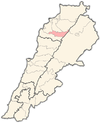Hadshit
History
Hadchit's ancient political center was located in Tyre. The government was Byzantine, so the natives were required to fight in the military or find employment. The inhabitants of Hadchit were a mixture of many peoples. The majority were Canaanites, Phoenician and Aramean, who later became known as the Syriac.
Nomination
There are several stories, namely: Phoenician: (Hadash) new moon or half-moon, so Hadsheet would mean the “new one” or the “new village”. Syriac: It means one of the six temples that were built by Batlimos the 5th (Ptolemy V), King of Egypt in Mount Lebanon according to the story narrated by Sheikh Antonios Abi Khattar in his book “The Synopsis of Lebanon's History”, (kept as a reference at the Jesuits Fathers’ library)
Religious role
There are many historical evidences indicating that our society helped in keeping the sect from collapsing against other beliefs. For example: – Patriarch Daniel Rizk (Hnein) from Hadchit 1278 (a.k.a. Patriarch Daniel II of Hadchit): In his era, the Maronites extracted the Chrism from olive oil and balm grease after it was extracted from 12 different greases. He died as a martyr while fighting courageously the Mameluk invaders for 40 days at Ehden gate. – David Ben Joseline: He was ordained in 1401 by the Patriarch John El Jaji and it seemed that this Bishop was a historian. He was succeeded by his nephew, David son of John Ben Joseline who was a historian and a Bishop in the days of Patriarch Ben Joseph Ben Jacob famous by the name of son of Hassan. Among the stories narrated about the constancy of Hadsheet people in serving the Church, we mention the story of Priest Jacob from Habsha who went on to Saint Georges’ Convent located in Kanoubin valley and surnamed it by the Convent of Habash. He was then sacked by the people of Hadsheet and was banished to the prairies. Among the religious monuments, we mention: The various Churches all over the village and its valley, namely: the Church of Saint Romanos, built under the supervision of Priest Bard El Hadsheeti, the Convent of the Cross which displays many drawings and sculptures on its walls, the Convent of Saint Chamouna, Mar Sarkis and Bakhos Church. In contemporary times the Rizk family administer the religious life within Hadchit.
Political role
Hadchit played an important role in leading the society although this role opposes the Maronites’ firm beliefs and the village's traditions. In the era of Major Abdul Mon’em Bin Assaf, the Jacobeans entered the society after it won over the grace of Major Bin Assaf who quarreled with the Patriarch. In attempt to reinforce his religious and political position, he called for some Jacobeans, and among them Hajj Hassan and made Hadsheet as their lodge. Among the Jacobeans who came to the village is the Priest Hanna who distinguished himself by changing the religious motives and trying to establish a laic law for the region's government with the support of the Major, as well as his brothers, Priest Elija who became a bishop and Chidiak Gerges.
The most prominent family of Hadchit is the house of Sheikh Mansour El Khoury, which had a very important role in the history of Hadchit and the Caza of Bcharri.
Many other prominent figures in the history of Hadchit were Sheikh Youssef El Khoury, known for his political influence in Northern Lebanon and Admiral Sheikh Antonio Ramon El Khoury Younes (Jūri Yunis), who had a great role in the politics of Venezuela in the mid 1900s.
The El Khoury Sheikhs of Hadchit's lineage goes back to the late 1700s, when they were endowed with their nobility title by the Ottoman Empire.
Economic status of Hadchit
The main source of economy in Hadchit society was agriculture. Therefore, irrigation channels were built as well as agrarian networks. Among its important products are apple, pear, etc... Although the industry in Hadchit is still at the rise of its progress, it is mostly active in the construction field and some craftworks as well as the production of alcoholic beverages.
Hadchit is becoming a sport centre as it offers climbers a unique climbing experience with the scenery of the Valley of Qadisha.
Notable People
- Darine Hadchiti | دارين حدشيتي
- Maronite Patriarch Daniel II of Hadchit
External links
- Hadchit, Localiban
- A lot of Information on Hadchit Archived 2019-07-05 at the Wayback Machine
- Official Website
References
- ^ "Rock Climbing in Hadchit, Hadchit". Mountain Project. Retrieved 2024-08-13.
